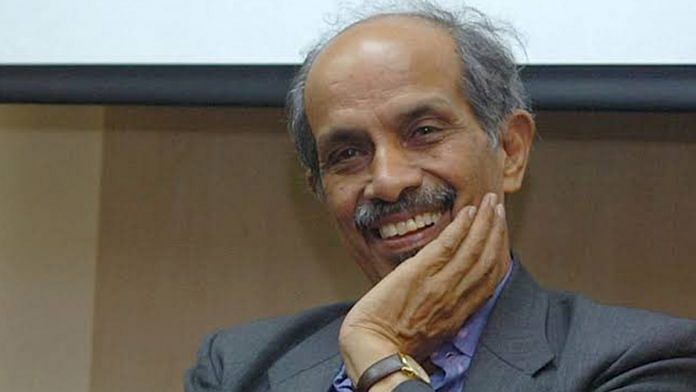Bengaluru: Famed aerospace scientist and fluid dynamicist Roddam Narasimha died at a private hospital in Bengaluru Monday, a week after he suffered a brain haemorrhage. He was 87.
Narasimha died from intracerebral bleeding. He leaves behind his wife and daughter.
News of his death was met with an outpouring of grief on social media from scientists across the country, with many hailing his unparalleled contribution to the aerospace industry.
Prime Minister Narendra Modi and President Ram Nath Kovind also condoled his death.
Shri Roddam Narasimha personified the best of India’s tradition of knowledge and enquiry. He was an outstanding scientist, passionate about leveraging the power of science and innovation for India’s progress. Pained by his demise. Condolences to his family and friends. Om Shanti.
— Narendra Modi (@narendramodi) December 15, 2020
Demise of eminent aerospace scientist Shri Roddam Narasimha is huge loss to the world of science and technology. An authority in fluid dynamics, he was honoured with Padma Vibhushan and many other awards and recognitions. My condolences to his family and his associates.
— President of India (@rashtrapatibhvn) December 15, 2020
In the past six decades, Narasimha made numerous contributions to several seminal aerospace programmes in India. He is most well known for his work on fluid dynamics — a study of the flow of fluids (liquid or gas) — that includes modelling cloud flows, structure of shock waves, and fluid dynamics at atmospheric boundaries.
Narasimha was a professor of aerospace engineering at Indian Institute of Science, Bengaluru, before becoming the director of National Aerospace Laboratories, and then the chairperson of engineering mechanics in Jawaharlal Nehru Centre for Advanced Scientific Research (JNCASR), Bangalore, as well as the director of National Institute of Advanced Studies (NIAS), Bengaluru.
He had also been a visiting professor at the California Institute of Technology (Caltech) and Cambridge University, among other universities, and held a visiting position at NASA Langley. He was also a Fellow of the Royal Society.
Narasimha held numerous fellowships of prestigious international science academies and societies.
He was conferred with the Padma Bhushan, India’s third-highest civilian award, in 1987 and Padma Vibhushan, the second-highest, in 2013.
Also read: This is how govt plans to bring together ISRO, private players to boost India’s space sector
Work and contributions
Born on 20 July 1933, in Bengaluru, Narasimha obtained his engineering degree from the University Visvesvaraya College of Engineering in 1953. He got his Masters from Indian Institute of Science (IISc), Bengaluru, in 1955, where he worked under Professor Satish Dhawan — widely regarded as the father of experimental fluid dynamics research in India.
Narasimha then moved to Caltech for his PhD under Dhawan’s recommendation, just as Russia launched the Sputnik satellite, which had a profound impact on his work as a fluid dynamicist in US during the Cold War.
“It was a turning point as it was seen as a national challenge to the United States. Therefore, they very quickly organized themselves to start a space programme,” said Narsimha in an interview.
At Caltech, he first worked on the problem of reducing noise in jet engines but the excitement around the space race pushed him to pursue work in rarefied gas dynamics with his doctoral advisor Hans W. Liepmann, who was a physicist and fluid dynamicist. He obtained his PhD in 1961.
The ‘Sputnik effect’ also led to research in aerodynamics and supersonic flows. After Caltech, Narasimha worked extensively on understanding the structure of shock waves with NASA Jet Propulsion Laboratory, on one of the space agency’s earliest computers.
In 1962, Narasimha joined the IISc’s aerospace engineering department, and started to work on turbulent flows and relaminarization — the switching of fluid flows from turbulent (chaotic) to a laminar (streamlined) form.
In 1982, he founded the Centre for Atmospheric and Oceanic Sciences there, which he headed.
Narasimha was the director of NAL between 1984 and 1993, the ISRO K.R. Ramanathan distinguished professor at IISc from 1994 to 1999, and the director of NIAS from 1997 to 2004.
He also held visiting positions at Caltech, Cambridge University and NASA-Langley in the US, University of Brussels in Belgium, University of Strathclyde in Scotland and Adelaide University in Australia.
Legacy
In the course of his life, Narasimha held numerous positions of importance in the country.
He was a member of the Scientific Advisory Council for former prime minister Rajiv Gandhi.
Narasimha was also a member of several scientific advisory committees and was the longest-serving member of the Space Commission — the highest policy-making body for matters related to space exploration in India.
In 2005, he resigned in protest after three former ISRO members were blacklisted during the Antrix-Devas money laundering scam.
As the director of NAL, Narasimha oversaw the development of advanced hardware and parallel computing. He also served on the board of Hindustan Aeronautics Limited (HAL) for several years.
He was also a part of the team that carried out an investigation of airworthiness under Satish Dhawan in 1970 into the Indian Airlines craft, Avro 748, after a flight crashed.
Narasimha authored more than 200 research publications and fifteen books.
Also read: Want to build satellites, rockets in India? Here’s how you can & challenges that lie ahead



